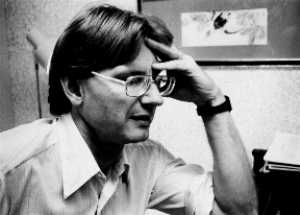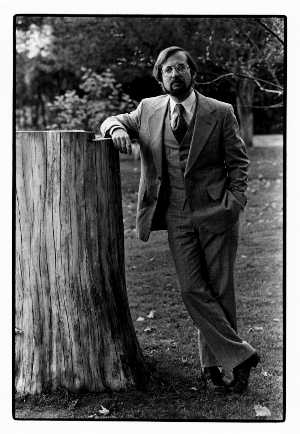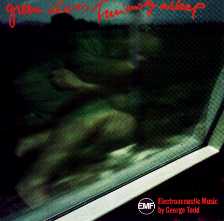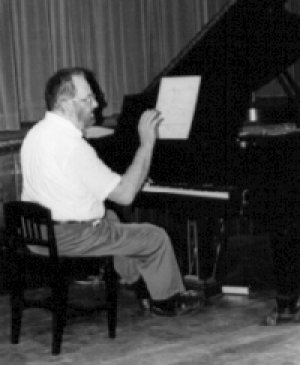
|

|
As you may surmise from the enclosed information, plans for a Bi-Regional Autumn Festival of Consortium Composers are coming nicely into focus. The catalyst for this event was Bill Harris and he deserves our special thanks for securing a Vermont Community Foundation Grant of sufficient value for us to confidently establish concert dates and engage performing artists for the Festival.
 This edition of Consorting includes a call for your scores and, in this
column, a suggestion that financial donations (of any size) from members and friends to help
with festival expenses will be accepted with sincere expressions of surprise and delight by
Don Stewart of Tunbridge on behalf of the Treasury! Neeedless to say,
the grant money and the present treasury won't cover all of our anticipated festival expenses,
and such funds, as well as payment of overdue dues (please) will lessen,
maybe eliminate, the need to spend our composing time in general fundraising.
This edition of Consorting includes a call for your scores and, in this
column, a suggestion that financial donations (of any size) from members and friends to help
with festival expenses will be accepted with sincere expressions of surprise and delight by
Don Stewart of Tunbridge on behalf of the Treasury! Neeedless to say,
the grant money and the present treasury won't cover all of our anticipated festival expenses,
and such funds, as well as payment of overdue dues (please) will lessen,
maybe eliminate, the need to spend our composing time in general fundraising.
And don't forget to send us some scores and tapes!
Best regards to all,
T L Read
November 2, Brattleboro:
Composers should submit scores and parts of works for the VCME combo directly to Steve Klimowski at RFD 1,
Box 295, Fairfax, Vermont 05454; "art" songs for soprano and piano directly to Lisa Jablow, RD, Plot
Road, Waterville, Vermont 05492; works for piano or piano and flute or flute alone to Diane Huling, c/o Bethany
Church, Main Street, Montpelier, Vermont 05602; and electronic/performance materials to Dennis Báthory-Kitsz
at 176 Cox Brook Road, Northfield, Vermont 05663.
Guidelines:
About the performers:
Zeke can be reached at Zeke_Hecker@brattleboro.vegs.together.org,
and Dennis can be reached at Contact Form Other contacts should be made
by mail.
Recent studies have pointed to a rise in levels of awareness and inventiveness early in
the day, after the initial drowse of awakening. Problems left over from the preceding
evening often snap into clear focus in the morning for a certain type of person. After a
morning's attention, lunch is a break followed by a period of rest, somnolence, in many
societies a conventional nap or siesta. Later in the afternoon, perhaps from four PM through
the early evening, physical strength is at the maximum; later a gradual decrescendo before
the day fades into sleep.
It is possible to consider programming music with a basic pattern, the normal pattern of
many uneventful days, in mind. In the morning evocative music, strong and clear in sound,
but not dominating. Lunch time is quiet, slow-paced, but later comes an almost meditative
music during the siesta period. Late afternoon would seem to call for strong thematic
material, energetic dynamics, leading to the evening recession with a full-sounding
tempered richness, which will taper off into the evening dream-world.
These are not hard to tabulate in the world of music, we have traditional paces which
virtually match the above categories, and New Music emulates the traditional ways most
in rhythmic patternings. But there are several yearly Seasons, each with dynamics of its
own. Without becoming as programmatic as Vivaldi, we can let the seasons modify our diurnal,
"circadian" patterns in subtle ways, much as classic Japanese haiku was able to key poems
and experience to the four climatic shifts.
In narrower focus, there are two changes which have a strong impact on most people. The bright
sunny days always seem to raise a certain expectation in our minds, while barometric shifts
in the direction of rain, even more sudden short barometric fluctuations as in the annual
Swiss Fon winds, can wreak emotional and semi-medical effects on the general population. So
we will want to make many varied changes in our seasonal and annual music-design, possibly
best done by computer generated data.
Entering the month and day gives us a rough place to start. Since the working week starts
with a lazy-Monday and ends with a hang-in-there-Friday, we should probably enter diurnal/weekly
data on the primary level. Time of sunrise and sunset are important events, but perhaps more
dynamic are the barometric data which indicate a sunny/cloudy prospect. Levels of relative heat
over a hundred degree F swing can be worked into our data. Events of national or international
importance appearing in newsprint and on TV may have a strong impact, e.g. the Oklahoma bombing,
the Savings and Loan scandals, a Presidential race for election.
By now we have an overly complex set of initial data, so we will have to introduce some loading
to make this into an operable system. If we load the most regular features with a factor of 1,
those which are most unusual and explosive with a factor of 10, and try different loadings for
the other functions on an experimental basis, we may find that our computer program can select
pieces to perform from a roster like this:
Is this a practical way of organizing a year's worth recorded instrumental music, ranging over a
wide spectrum of styles and dates, so as to provide a minimally-recursive Annus Musicalis at the
present time? The answer is clearly no.
But is this possible, and even more is it a worthwhile project to pursue as a way of bringing to an
extended audience a wealth of many thousands of pieces of music which might never otherwise be heard
at all? Here the answer, in the world of "what can come to be...", is decidedly in the affirmative.
Electronic Music Foundation, 116 North Lake Avenue, Albany NY 12206
Submitted by William Harris
Now that we have current technology for doing the same thing on telephone communications,
only much better and cheaper, we have a good avenue for finding a viable social use for New Music. For
years the government has been allotting a decent percentage of the cost of every federally funded building
for "art-work", which usually appears as a giant lump of stone in a shallow pool of water, or a
wall of brash paint which often seems to go nowhere and look as if it came from nowhere as well. Of course
some artwork is great, if it is good work, properly sited, and consonant in some un-obvious way to the
intent of the building. No more Scales in the foyer of a Courthouse, muscular workers in low-relief stainless
steel above the door of a Welfare Office. Abstract design has the advantage of looking quizzical when
installed, and not losing this curious quality over a couple of generations.
I believe that it is worth bringing to the NEA a proposal for an assemblage of a week's New Music
from the Consortium, to be installed in various locations of an important Federal building, on an annual
contract for four such interchangable "sets" scaled for a 40-hour week if daytime use, or a
continuous replay if the building is used continuously. Airports, train stations, courthouses, medical
buildings, Government Offices as well as the halls of private corporations -- there is a lot of empty space
sitting around unused.
Briefly, there are several direct steps:
There may be no interest at all in today's bad-taste world, but then again there may be
a sigh of relief to hear interesting sound in places where there was before nothing but the shuffle of shoes.
Nothing tried...
The Kalvos & Damian New Music Sesquihour, heard Saturdays from 2:30 to 4:30 in the
afternoon on WGDR-FM 91.1 in central Vermont, finished its first year on the air in mid-May.
Vermont composers have continued to be featured, but show hosts Dennis Báthory-Kitsz
and David Gunn looked into the community of European composers and found
it rich with music, ideas and food. So from March 14-27, the show traveled to New York, Amsterdam, Cologne,
Brussels and Paris to interview composers and composer/performers: Klarenz Barlow,
Marc Battier, Henning Berg, Peter Beyls, Rhys Chatham, Nicolas Collins, Maria DeAlvear, David Dramm, Anne LaBerge, Benedict Mason, Mary Oliver, Robert HP Platz, Eliane Radigue, Kaija Saariaho, Laurie Spiegel, Steven Stusek, Richard Tolenaar, and Calliope Tsoupaki.
Since the last issue of Consorting, many other composers have appeared on the show, including
Michael Arnowitt, Susan Bettman, Joel Chadabe, Dennis Darrah, Jody Diamond, Steven Gryc, Zeke Hecker, Fred Ho, David Kraus, John Levin, Keith Moore, Larry Polansky, Carl Stone, Peter Tavalin, George Todd, Scott MX Turner. Pauline Oliveros will appear on May 18, and future guests will include Charles Dodge, Randall Neal, Barbara J. Wellspring, Jaron Lanier, Mark Lindsey, David Stevens, John Bussey, Robert Wigness, Elma Miller, Dr. Nerve, Robert Train Adams, Richard DeCosta, Bill Gilliam, Jim Lynch, Tom Johnson, Randy Rare, and Alcedo Coenen.
Join us. Contact Kalvos at 802-485-3972 or Damian
at 802-244-1747.
Board:
David Gunn,
Craig Hanson,
Bill Harris,
Zeke Hecker,
Dennis Báthory-Kitsz,
Maria Lattimore,
Ed Lawrence,
Peggy Madden,
Don McLean,
Erik Nielsen,
Bea Phillips,
Thomas L. Read,
Don Stewart,
Gwyneth Walker,
Batya Weinbaum.
1996 Fall Festival of Vermont Music
November 3, Manchester:
November 9, Montpelier:
November 10, Burlington:
 Composers should submit scores and parts of works for string quartet or piano trio, and
singer songwriters should submit sheet music, lead sheets, and/or tapes to Zeke Hecker, RFD 3, Brattleboro,
Vermont 05301. Call 802-257-1028 for more information.
Composers should submit scores and parts of works for string quartet or piano trio, and
singer songwriters should submit sheet music, lead sheets, and/or tapes to Zeke Hecker, RFD 3, Brattleboro,
Vermont 05301. Call 802-257-1028 for more information.
Performers and groups are professional and we have the Vermont Community Foundation grant and
other funds to secure their services. A modest admission fee will be charged for each concert. The southern
concerts are co-produced by Friends of Music at Guilford. Each performing unit will present between 40 minutes
and one hour worth of music.
In sum, we are looking for: string quartets; piano trios; art songs; solo piano works; works for
flute; performance and electronic pieces; VCME combination work (though piano trio material goes to Zeke); and
songs from our singer/songwriters. We are also looking for financial contributions.Music for the Day and the Year
Any set of orchestrative devices can be associated with any of the above classes, but the rhythmics
may well fall in a range of one to ten spread over the above groups in the order listed.Weinbaum’s Fragments
Treasury Report
******** EXPENSES ******** 1997 1996 Concert 1995 projected projected Breakout actual Newsletter printing 600 500 368 Newsletter postage 400 300 200 Produce tapes 100 0 0 Other printing 0 100 0 Office/office expenses: 50 Phone 100 100 118 Postage 100 100 87 Travel 435 Netsite work 100 100 Concert production s=1600 Musician fees 3000 3400 n=1800 Space rental 300 400 400 Equipment rental 200 300 300 Publicity 300 350 350 Entertainment/Hospitality 100 100 100 Accounting/Legal 200 200 Bank charges 10 10 Contingency 200 100 100 TOTAL EXPENSE 5710 6060 4650 1258 ********* INCOME ********* Members Dues 1500 1500 500 1280 Non-Member Subscriptions 30 50 0 0 Contributions from Members 200 200 95 Sales of Services (tapes) 200 0 5 Sales of Mugs, etc. 100 100 75 Contribs. from Non-Members 200 0 0 Admissions 1500 1000 1000 Special Contributions 400 250 250 Grants (VCF) 2100 2100 Grants (Vt. Nat. Bank.) 800 800 Grants (VCA) 1500 TOTAL INCOME 5630 6000 4650 1455 End-of-Year Balances 57 137 197 Listkeeping Note
Editor Request
Green Ideas Furiously Asleep
 George Todd's new CD is out! It is 73.39 minutes of music from l982 through l992, an excellent selections
of the carefully prepared re-synthesized sounds which Todd is well known for, in a thoughful matrix of rhythmic devices.
The disc is available from:
George Todd's new CD is out! It is 73.39 minutes of music from l982 through l992, an excellent selections
of the carefully prepared re-synthesized sounds which Todd is well known for, in a thoughful matrix of rhythmic devices.
The disc is available from:
(518) 434-4110 Voice / (518) 434-0308 Fax / Email: EMF@emf.org. For a full listing of
the recordings EMF has prepared and plans for work in progress, see: http://www.emf.orgBy-Laws, Articles & Minutes
Call for Scores
Networking Update
The Reflecting Pool
 But we are talking about music. There have been numerous combinations of a dimensional piece of
art, fixed or static, accompanied by a continuous recording of music; the SEAMUS Journal, last edition,
mentioned one such arrangement with a 22.5-minute tape as an early venture. But when music accompanies visual
display, it is usually the music which gets missed, as in cinema and current TV stories. Even an MTV show of
Brendel on Beethoven's 5th piano concerto gives a lot more detail to the pictures than the music. After it is
over you might better pull out your old CD and listen carefully in a darkened room -- just listen to just the
music.
But we are talking about music. There have been numerous combinations of a dimensional piece of
art, fixed or static, accompanied by a continuous recording of music; the SEAMUS Journal, last edition,
mentioned one such arrangement with a 22.5-minute tape as an early venture. But when music accompanies visual
display, it is usually the music which gets missed, as in cinema and current TV stories. Even an MTV show of
Brendel on Beethoven's 5th piano concerto gives a lot more detail to the pictures than the music. After it is
over you might better pull out your old CD and listen carefully in a darkened room -- just listen to just the
music.
How can this be started? First draw up a Proposal for the Project, submit to NEA through all the
normal sources, certainly speak to some people in State Government for support, and if a small starter-grant
can be secured, make up a coherent sample tape to be delivered on current communication lines to a site which
find the idea intriguing. With net communications the idea can be documented and advertised easily.Nelson Premieres Walker
 On February 4, 1996, Mark Nelson, tuba and the Millikin/Decatur Symphony Orchestra, Wesley Tower,
conductor, premiered Gwyneth Walker's Chanties and Ballads, Songs of the Sea for tuba and
orchestra. The concerto had been in preparation for over a year and was warmly received by the audience.
Ms. Walker was in attendance at the premiere at the 2,000-seat Kirkland Fine Arts Complex on the
campus of Millikin University in Decatur, Illinois. Nelson will play the concerto again at the
annual Cabaret concert April 12 and at the Young People's Concert April 14.
Submitted by Mark Nelson.
On February 4, 1996, Mark Nelson, tuba and the Millikin/Decatur Symphony Orchestra, Wesley Tower,
conductor, premiered Gwyneth Walker's Chanties and Ballads, Songs of the Sea for tuba and
orchestra. The concerto had been in preparation for over a year and was warmly received by the audience.
Ms. Walker was in attendance at the premiere at the 2,000-seat Kirkland Fine Arts Complex on the
campus of Millikin University in Decatur, Illinois. Nelson will play the concerto again at the
annual Cabaret concert April 12 and at the Young People's Concert April 14.
Submitted by Mark Nelson.WriteFaxEmail!
Young Composers Competition
 The National Young Composers Competition is sponsored by a grant from BMG Music Service and is managed by Williams
College. There are three grand prizes of $10,000, and winning works will be premiered at the Berkshire New Music
Festival in October 1997. Deadline: March 3, 1997. Composers must be not more than 23 years old by March 1, 1997.
For more information, call Hilary Greene, Program Manager, at 413-597-3730, at 5 Southworth Street, Williamstown,
Massachusetts 01267, or by email at composer@williams.edu.
The National Young Composers Competition is sponsored by a grant from BMG Music Service and is managed by Williams
College. There are three grand prizes of $10,000, and winning works will be premiered at the Berkshire New Music
Festival in October 1997. Deadline: March 3, 1997. Composers must be not more than 23 years old by March 1, 1997.
For more information, call Hilary Greene, Program Manager, at 413-597-3730, at 5 Southworth Street, Williamstown,
Massachusetts 01267, or by email at composer@williams.edu.Kiraly Music Network
Electronic Music Foundation Calendar
EMF Calendar is a publication of Electronic Music Foundation, Inc., 116 North Lake Avenue, Albany, New York 12206.
Telephone 518-434-4110 voice, 518-434-0308 fax. Email calendar@emf.org to subscribe,
or find them at http://www.emf.org
A wide variety of classes in recording theory and skills (the 4th annual Stephen F. Temmer Tonmeister summer program)
and in the theory and composition of new music (Composing Seminar). NYU is centrally located in New York City amidst
concerts, restaurants, clubs, and everything else. Find them at http://www.nyu.edu/summer
Classes and workshops in many subjects dealing with computers and music, including psychoacoustics and virtual reality,
audio and haptics, computer-assisted musicology, algorithmic composition, and digital signal processing. And there's a
concert scheduled for July 18 at Stanford's Frost Amphitheatre. Find them at http://ccrma-www.stanford.edu
Discussions, lectures, concerts, courses about new music in German, English, and French. Contact: Internationales
Musikinstitut Darmstadt (IMD), Nieder-Ramstädter Straße 190, D-64285 Darmstadt, Germany; (49)(6151)132416 Voice;
(49)(6151)132405 Fax
Workshop subjects include sequencing (using Vision, MusicShop, Performer), music printing (Finale), synthesizer
programming (Galaxy), sampling (Sound Designer, Alchemy, TurboSynth, SoundHack), alternate MIDI controllers, and
algorithmic composition (M, MAX). Find them at http://talbert3.con.oberlin.edu/dept/wrkshp.html
A short but powerful conference on aspects of computer music, including papers, research updates, and concerts dealing
with all aspects of computer music and the application of computers to musical problems. Find them at http://www.ircam.fr/jim96
This year's annual and international electronic-music festival in Bourges, presented by the Institut International de
Musique Electroacoustique, features concerts and installations and all kinds of approaches to electronic music presented
in the most beautiful environment of the theatre and courtyard of Jacques Coeur. (Bourges also has one of the stunning
cathedrals in France.) Find them at http://www.gmeb.fr
A festival of new music organized by a Chicago-based group of musicians and others. NEMO is an acronym for New European
Music Overseas, and the festival accordingly contains music by Karlheinz Essl, Eliane Radigue, Kaija Saariaho, Judith Weir,
and many other European composers and performers. The festival includes a 'NetEvent' at Navy Pier, a cyber-assisted
showcase of new music, which will allow visitors to experience the interaction between new music and art. Excerpts from
the music are available on the web-based 'Gallery of Sound'. Find them at http://www.synasoft.com/nemo/
Music by Jorge Antunes, Jacques Lejeune, Daniel Teruggi, Serge De Laubier, Kaija Saariaho, Benjamin Hertz, Lionel Marchetti,
Francis Larvor, Patrick Ascione, Ilhan Mimaroglu, and Michel Chion will be performed at various locations througout Paris
in the 'Cycle Acousmatique' concert series. Information from Maison de Radio France, Salle Olivier Messiaen, 116 ave du
Président Kennedy, 75016 Paris, France.
Two days of music and research presentations on all aspects of computer music, organized by SBC (Brazilian Computer Society).
Information from sbcmIII@npd.ufpe.br
The most important annual conference in electronic music research. Workshops, papers, concerts, installations, in short
all manner of events dealing with computers, electronics, and music. Contact ICMCreg@cs.ust.hk
An annual festival of electronic arts, including the Prix Ars Electronica 1996 for outstanding work in web art, computer
animation and computer music. This year's theme is 'Memesis: the Future of Evolution' and this year's festival coincides
with the opening of the the new Ars Electronica Center (Museum of the Future). Find them at http://www.aec.at
Computer music on tape from 5pm to 7:45pm; concert at 8pm including 'La Barbara', 'AccidentsTwo', 'art is
self-alteration is Cage is...', 'BluesAx', and 'Life Pulse Prelude'. For ticket information, call Merkin Hall box office
at 212-501-3330
This year ISEA (International Society for the Electronic Arts) is presenting a multiple festival of the electronic arts,
including music, film, video, interactive installations, and all manner of cutting-edge events: ISEA96 encompasses
DEAF96 (Dutch Electronic Arts Festival, September 17 to 22) and R96 (City-Wide Festival on New Media, September 16 to 29).
Find them at http://www.xs4all.nl/~isea or http://www.eur.nl/ISEA96
Kalvos & Damian Show Finishes a Year on the Air
Program and Website
by Kalvos or DamianConsorting
Published by the Consortium of Vermont Composers
Thomas L. Read, Director
Dennis Báthory-Kitsz, Editor-in-Flux
Don Stewart, Treasurer
Craig Hanson, Listkeeper![]()
![]()
![]()
![]()
![]()
![]()